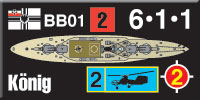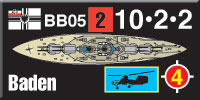The Cruel Sea:
German Battleships, Part One
by Mike Bennighof, Ph.D.
May 2022
 Our Second Great War at Sea series of alternative-history expansions is designed to highlight battleship combat. The setting is built to justify battleship fleets, and the scenarios are crafted to provide lots of battleship action. Our Second Great War at Sea series of alternative-history expansions is designed to highlight battleship combat. The setting is built to justify battleship fleets, and the scenarios are crafted to provide lots of battleship action.
The dominance of air power in the Second World War overshadows the technological developments of the battleship during the decades between the World Wars, in terms of armament, protection and gunnery direction. Our Second Great War setting is deliberately crafted to allow players to explore these new capabilities in massed battleship actions without clouds of powerful aircraft interfering. The big gun is the arbiter of sea power.
The Cruel Sea, our massive expansion set, makes the battleship its centerpiece. Imperial Germany’s High Seas Fleet features 35 battleships, ranging from a decrepit gunnery training ship to a sextet of huge, powerful fast battleships. Let’s take a look at them.
The Training Ship
 A single leftover from Imperial Germany’s second class of dreadnoughts, Helgoland has been heavily modified to serve as a sea-going classroom for future gunners. One of her boiler rooms has been converted to berthing space, and her armament has been heavily modified, with her original wing turrets replaced by a pair of 8.2-inch (210mm) dual mounts forward and a set of 5.9-inch (150mm) mounts aft. A single leftover from Imperial Germany’s second class of dreadnoughts, Helgoland has been heavily modified to serve as a sea-going classroom for future gunners. One of her boiler rooms has been converted to berthing space, and her armament has been heavily modified, with her original wing turrets replaced by a pair of 8.2-inch (210mm) dual mounts forward and a set of 5.9-inch (150mm) mounts aft.
Germany’s first two classes of dreadnoughts resisted attempts at modernization; the inefficient “hexagon” layout of their main armament combined with their outdated triple-expansion engines (rather than the turbines of almost all other nations’ dreadnoughts) to stymie efforts to create a useful modern fighting ship. Navy chief Eduard von Capelle had proposed retiring them as early as the spring of 1916 – less than four years after the last of them was commissioned. Helgoland could still provide service in her training role; the High Seas Fleet takes in thousands of new conscripts every year who need to familiarize themselves with the fleet’s weapons before they can be sent to a ship.
As such, she has little military value, but she might show up accidentally in a combat zone – due to Germany’s plethora of enemies and her geographic positions, there aren’t a lot of safe zones.
Design Notes: The drawing came out of my musings over how the older dreadnoughts might have been modernized for the Second Great War, either in German service or sold on somewhere else. I came to the conclusion that no one would have wanted them, because of the old-style engines and terrible layout.
The old High Seas Fleet had run into a manning crisis even before the Great War; the fleet could conscript plenty of sailors, but still had to train them. The Navy would have had a great need for training ships during the period between the wars.
King of Battleships
 The oldest German battleships still in service, the four ships of the König class carry a lighter main armament than most foreign battleships and so are limited in the roles they can fill. Veterans of the Great War, they’ve lost their amidships turret to allow new, more efficient oil-fired boilers in place of the mixed coal-and-oil arrangement with which they were built and modern turbines to replace their early models. The oldest German battleships still in service, the four ships of the König class carry a lighter main armament than most foreign battleships and so are limited in the roles they can fill. Veterans of the Great War, they’ve lost their amidships turret to allow new, more efficient oil-fired boilers in place of the mixed coal-and-oil arrangement with which they were built and modern turbines to replace their early models.
The new boilers had their exhaust all trunked into one large funnel, a feature of a number of battleships and battle cruisers designed during the last years of the Great War. That provided enough space for a large helicopter hangar with two landing-deck spots. Their torpedo tubes, a noted weak point in their protection scheme, have been removed and their deck armor thickened.
Their secondary armament has been removed from casemates and replaced by a smaller number of guns (just four) in a pair of dual turrets; they also sport a quartet of 105mm anti-aircraft guns in dual mounts plus lighter anti-aircraft weapons.
The relatively light-weight main armament would have placed them at a paper disadvantage when standing in the battle line against British ships armed with 15- or 16-inch guns, but the well-tried 305mm L/50 guns matched the range of those weapons. They would not be as likely to penetrate the thick skins of British battleships as would be bigger 15- and 16-inch guns of later-model German ships. They would, however, greatly out-range the guns of enemy cruisers and that made the old battleships very fine convoy escorts, especially in waters where the big Russian cruisers with 10-inch guns might be encountered.
The Baseline
 The Bayern class, called the Baden class in some literature, would become the baseline design for German battleships for the next generation – what writer Siegfried Breyer would call the “peak of perfection.” Two forward, super-firing turrets each with a pair of 15-inch guns were mounted forward, and a matching pair aft. The Bayern class, called the Baden class in some literature, would become the baseline design for German battleships for the next generation – what writer Siegfried Breyer would call the “peak of perfection.” Two forward, super-firing turrets each with a pair of 15-inch guns were mounted forward, and a matching pair aft.
Only two of the four ships in the class were completed for service in the First Great War, entering the fleet after the Battle of Jutland. All four would have been modernized during the decades between the two Great Wars, having their mixed-firing boilers replaced by oil-fueled models. Like the König class, they had their secondary armament moved from casemates to turrets, and reduced in number (eight guns in four turrets), and also eight 105mm anti-aircraft guns in four dual mounts. As with the previous class, they lost their torpedo tubes and gained a helicopter pad.
The helicopter pad aft includes below-decks stowage for two small machines, but not a true hangar with service areas like the König class.
You can order The Cruel Sea right here, right now.
Sign up for our newsletter right here. Your info will never be sold or transferred; we'll just use it to update you on new games and new offers.
Mike Bennighof is president of Avalanche Press and holds a doctorate in history from Emory University. A Fulbright Scholar and NASA Journalist in Space finalist, he has published a great many books, games and articles on historical subjects; people are saying that some of them are actually good.
He lives in Birmingham, Alabama with his wife, three children, and his Iron Dog, Leopold. Leopold is hanging on.
Want to keep Daily Content free of third-party ads? You can send us some love (and cash) through this link right here.
|
